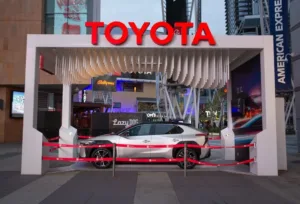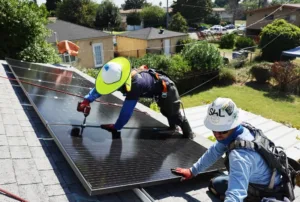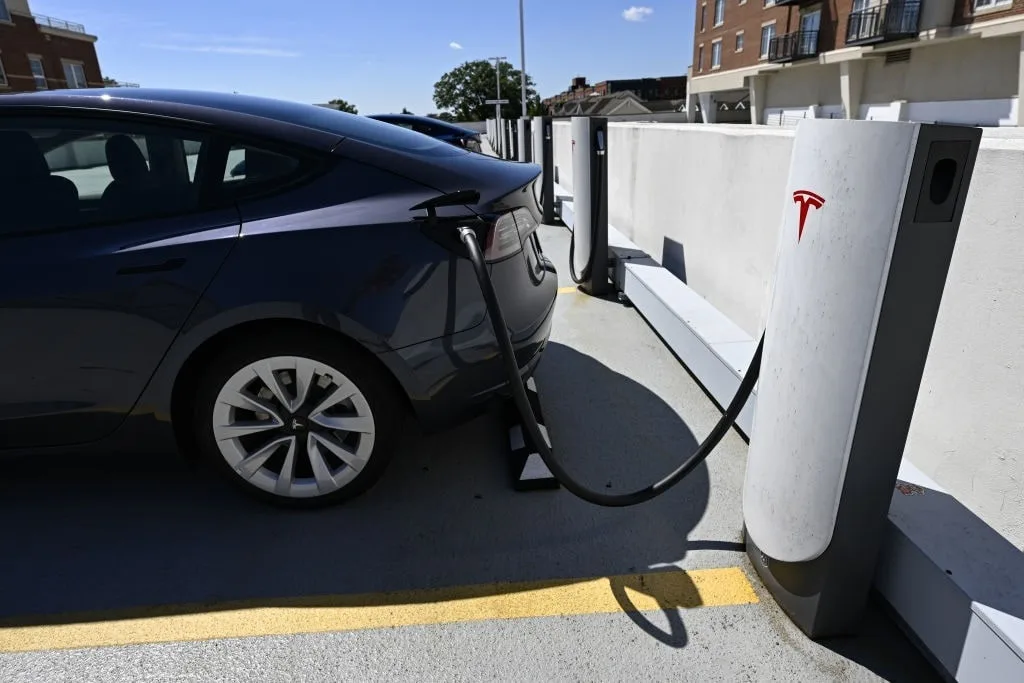A new Texas study calculates the full costs of operating electric vehicles (EVs) approach the equivalent of $17.33 per gallon. Doubtless, battles will be waged over the accuracy of these calculations. But what is indisputable is that these various costs, whatever their amount, are being passed on to low-income Americans who could not afford a new car, let alone an EV. Indeed, the government is compelling even people who don’t drive at all to pay for the fancy cars of those who can afford to do so. Similar regressive wealth transfers accompany solar panel and heat pump programs, which are equally inequitable.
The Texas Study

(Photo by George Rose/Getty Images)
An October 2023 study by the Texas Public Policy Foundation assessed the various direct state and federal subsidies for (EVs), as well as indirect supports including infrastructure and transmission costs. Though the study comes a bit late in the game, surely including these various additional expenses is necessary to measure the true cost of an EV. The question must be asked why the government that has essentially taken over the manufacturing of EVs and solar panels by regulatory fiat has not undertaken this analysis. But Americans may also ask – since these cars are subsidized so heavily and inequitably – why they will keep being touted as the environmental cure-all and manufactured anyway.
EVs share four attributes with solar panels, heat pumps, and many other government initiatives to save the planet from carbon dioxide. They aren’t commercially viable without government mandate, they’re regressively paid for on the backs of low-income taxpayers, they are much more expensive than touted, and the manufacturing process is counterproductive for the goal of saving the environment.
While noting that “Billions in credits for EVs translate into negligible real-world fuel economy improvements,” the Texas study mostly addresses the third attribute, concluding that the true cost of operating an EV is approximately $17.33 per gallon in today’s dollars once sizeable state and federal subsidies and indirect supports are factored in. Doubtless EV proponents will poo-poo the amount of costs attributed to EVs by the analysis, including challenging the ten-year, 120,000-mile lifespan of the cars used for the study. But the fact that huge subsidies are allocated is indisputable: The International Monetary Fund recently cautioned that spending on climate change initiatives threatens to inflict a global debt crisis, led by the United States.
Regressive Payouts

(Photo by Celal Gunes/Anadolu Agency via Getty Images)
These costs are passed on to taxpayers who cannot afford expensive cars or may not drive at all. When the federal and state governments allocate huge sums for fancy cars (knocking an estimated $50,000 off the true price tag, according to this study), it is extracting that money in part from low-income taxpayers who are struggling with housing and food inflation. The researchers estimate that “EVs receive nearly seven times more credits under federal fuel efficiency programs than they provide in actual fuel economy benefits.” And many of the Americans indirectly footing that bill may use mass transit or walk to work on foot.
This nasty little secret is ardently swept under the rug by so-called “progressives.” Renewable energy programs are patently regressive, meaning they transfer wealth from poor people to rich people under the guise of saving the world. Solar panels are subsidized similarly to EVs, using massive state and federal credits that are funded by raising electricity rates. For instance, Vermont’s Department of Public Utilities estimates that the Green Mountain State’s net metering program (which subsidizes rooftop solar installations through electric rates) increases electricity costs by $37 million annually. Retirees on shrinking fixed incomes are paying ever more in taxes, indirectly through electricity rates.
Renewable boondoggles are not just regressive: They are also inefficient. The Texas study observed that the highly subsidized batteries used in EVs would better serve the environment elsewhere:
“First and foremost are the tax credits, grants, and loans for domestic battery manufacturing, which is by far the most expensive component of an EV. … Toyota estimated that the amount of materials to make one EV battery can be used to make 90 hybrid batteries and that those 90 hybrids will result in 37 times more emissions reductions over their lifetime than one EV.”
Solar Panels Compared

(Photo by Mario Tama/Getty Images)
Similar complaints can be made about solar panels, especially when subsidies for rooftop arrays are contrasted with more efficient solar farms. If the goal is to reduce energy use and industrial waste, why would the government subsidize expensive individual homeowner solar arrays? A solar farm costs between $0.80 and $1.30 per watt to build “rather than the $2.86 per watt average cost of a residential installation.” Yet regressive subsidies compelling grandma to pay for her rich neighbor’s non-recyclable solar array (while she heats with electricity) continue unabated.
Another example of the renewable scam is found in the unending (though counterproductive) ethanol program, which dramatically increases industrial corn production. It also drives up corn prices for human food, just as EV subsidies drive up lithium prices unsustainably. A 2016 Yale study determined that “ethanol has been antithetical to fuel economy” and “While the overall impacts on climate remain uncertain, there is no clear evidence that ethanol is part of the solution rather than the problem.” Yet the subsidized stuff still goes into Americans’ gas tanks, by law.
Regressive Renewables Redux
Climate change profiteers don’t want consumers looking behind the regulatory curtain, peering at the filthy lucre being harvested from their children’s futures in the false name of saving them. The world is threatened with total economic collapse and hyperinflation of energy costs, and the policy failures of renewable energy might end society long before climate change.




